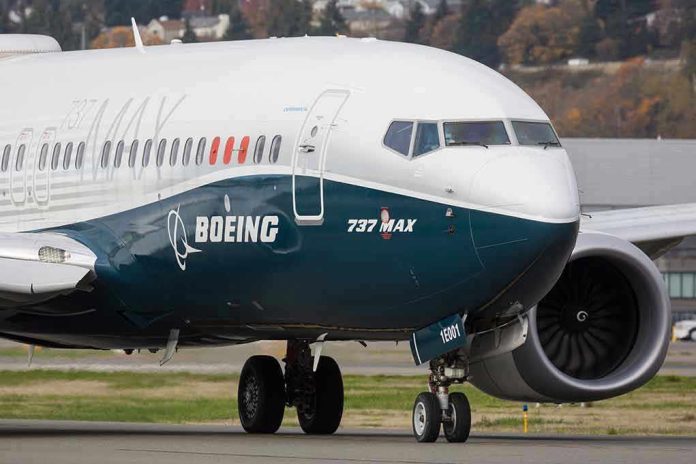
One of America’s industrial giants just admitted a $4.9 billion misfire on a single aircraft program, and the shockwaves are about more than money—they’re about the future of U.S. aerospace dominance.
Story Snapshot
- Boeing’s 777X program triggered a $4.9 billion pre-tax charge, slashing quarterly profits and spotlighting deep certification delays.
- The FAA’s heightened scrutiny after the 737 MAX crisis has upended Boeing’s flagship timeline, shaking investor and airline confidence.
- Boeing’s commercial backlog remains huge, but the loss exposes vulnerabilities to Airbus’s growing market power.
- The 777X delay underscores a wider industry reckoning with regulatory rigor and global supply chain challenges.
Delayed Dreams: The 777X Charge and What It Means for Boeing’s Future
Boeing’s October 29, 2025 earnings report didn’t just deliver numbers—it delivered a gut punch. A $4.9 billion charge tied to certification delays on the 777X program left a $7.14 per share loss on the balance sheet, with $6.45 of that loss coming from the 777X alone. This wasn’t a hiccup or rounding error. It was a public admission that Boeing’s “next big thing” is mired in regulatory quicksand at a time when the stakes couldn’t be higher for the company’s future in wide-body aviation.
Certification delays—rather than production failures—are to blame. The Federal Aviation Administration (FAA), still reeling from its own bruises after the 737 MAX disasters, has adopted an ironclad approach to new aircraft approvals. For Boeing, this means the 777X is stuck in a holding pattern, with each extra month translating into millions in lost opportunity and shaken customer trust. The reality? Airlines who booked the 777X as the backbone of their future fleets are now recalibrating their plans, and shareholders are left clutching thinner wallets and longer timelines.
Boeing’s Recovery: Between a Rock and a Hard Place
Boeing is not new to turbulence, but this hit comes when the seatbelt sign has been on for years. Following the 737 MAX grounding and public quality control stumbles, the company has clawed back to positive operating cash flow—$1.1 billion—with a commercial backlog of $636 billion and over 5,900 airplanes on order. Yet, the 777X charge consumes nearly a fifth of its quarterly revenue. The company’s ability to keep 737 production rising signals resilience, but the shadow of the 777X looms over every earnings call and boardroom conversation.
Shareholders, employees, suppliers, and airlines are all in the blast radius. Employee morale and job security hinge on the 777X’s eventual success. Suppliers must weather delayed orders. Airlines see their own competitive timelines slipping, forced to lean harder on aging fleets or consider Airbus alternatives. For investors, the path to sustained profitability stretches further into the horizon, and each earnings report becomes a test of patience and faith in Boeing’s turnaround story.
Regulatory Power and Market Chess: FAA, Airbus, and the Stakes for U.S. Aviation
The FAA’s post-MAX posture is reshaping the landscape for every manufacturer. Boeing’s ability to deliver new products is now directly linked to regulatory goodwill and compliance, not just engineering prowess. This power shift means Airbus, Boeing’s primary rival, can capitalize on the delays, courting airlines with more certain delivery schedules and proven aircraft. The longer the 777X waits for its green light, the more entrenched Airbus becomes in the long-haul, wide-body segment.
Airlines and industry analysts are watching closely. Will Boeing’s reputation for innovation survive another year of delays? Can the company regain its place as a trusted partner for the world’s largest carriers, or will the 777X’s woes mark the beginning of a slow retreat in market share? The outcome will shape not only Boeing’s future, but the entire competitive dynamics of global aviation for years to come.
Shockwaves Down the Supply Chain and Across the Industry
The 777X delay doesn’t just stall jets in Seattle—it ripples through the entire aerospace supply chain. Component manufacturers face extended wait times and tighter margins, while downstream effects reach small businesses and communities dependent on Boeing’s production lines. The broader industry, meanwhile, sees regulatory rigor as the new normal. No shortcuts, no assumptions—every nut and bolt must pass the test, or risk repeating the tragedies of the past.
Legacy, pride, and economic might are now all on the table. As the world’s airlines and financiers weigh their bets, Boeing’s next moves will define not just its own renewal, but the narrative of American industrial leadership in the face of adversity. The 777X’s future is still unwritten, but with every quarterly report and regulatory update, the stakes get higher—and the audience, restless for a comeback, grows more impatient.
Sources:
Boeing Media Room press release dated October 29, 2025
Boeing Investor Relations official press release



